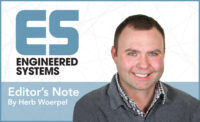While the advent of membrane-based rooftop air conditioners, VRF, energy storage, and a number of other technologies appear to be testing the limits of energy efficiency, the International Energy Agency (IEA) believes the industry is miles from touching its proverbial glass ceiling.
GLOBAL EFFICIENCY
In its “Energy Efficiency 2018: Analysis and Outlooks to 2040” report, the IEA boasts the world could effectively double its air conditioning efficiency by 2040. To accomplish this goal, the IEA established its Efficient World Scenario (EWS), which lays out a plan for multiple countries to reach these goals through a mix of system replacements, regulatory actions, and efficiency upgrades.
The study insists while building space will increase by 60 percent over the next 22 years, the EWS will eliminate any additional energy use as well as offer as much as a 60 percent savings on space heating, cooling, and water heating costs.
All of this sounds great, doesn’t it?
I hate to be a “Debbie downer,” but you probably have a better chance of winning the Mega Millions lottery than seeing this plan come to fruition. While the global market has a number of its own challenges, here are a few reasons why this plan simply won’t work in the U.S.:
-
Regulatory Reform: Achieving the EWS’s goals would require rigorous regulatory reform. Comprehensive efficiency policies targeting both new and existing building stock and the comfort equipment within would need to be enacted. Improvements in equipment performance would also require strengthened standards for key industrial equipment, including electric heat pumps, motors, and more. Rather than increasing the budget for energy efficiency, all signs point to the U.S. government slashing efficiency funding. In August, the Trump administration announced its intention to roll back several of former President Barack Obama’s efficiency initiatives, including the Clean Power Plan, which is currently blocked by a court stay.
-
Cost: According to the report, the adoption of the necessary technologies and equipment replacements would require efficiency investments to double between now and 2025 and then double again after 2025. While the price tag is hefty, the EIA claims such investments would provide a return on investment by an average factor of three based on energy savings alone. As previously noted, the Trump administration has shown a desire to cut efficiency programs, not increase funding. Such an example would be the U.S. EPA’s Energy Star program, which has been on the chopping block several times since Trump took office.
-
Repair Versus Replace: While the efficiency of best available air conditioning technology has continued to improve, there is a significant gap between the most efficient technology and average equipment. Based on SEER and EER ratings, global best available air conditioning equipment is up to five times more efficient than the least efficient equipment. However, building owners don’t replace equipment out of boredom; a system replacement is most often done out of necessity. Many owners won’t touch equipment until it fails. When it does fail, many think with their bottom lines, opting to fix the equipment first, as that’s typically the cheaper option. The idea that every building in America will upgrade equipment simply because it’s available is a fallacy.
-
Lack of Workers: Such a spike in efficiency levels and system retrofits would spur great economic activity in the trades. The problem is, there simply aren’t enough qualified workers to perform such work. Undoubtedly, when speaking with HVACR engineers, contractors, and distributors, their No. 1 issue revolves around finding qualified work. Many companies and firms are turning jobs away simply because they can’t keep up with the demand.
THE FUTURE OF EFFICIENCY
While it’s unlikely the planet will double its air conditioning efficiency anytime soon — and certainly not by 2040 — it’s refreshing to see an organization like IEA publish a playbook that gets us to that point. While we may not be able (or willing) to deliver the owners, coaches, players, training program, or offseason regimen necessary to execute the winning plays, it’s good to know that, with the right pieces in place, we at least know what it’ll take to win the game.
ES WEBINARS
Register for our free webinars at http://webinars.esmagazine.com, where users can also view any webinar from the last year on demand in our archive.
DECEMBER 12
Electrical Protection of Standby
Generators
Presented by Tim Coyle
Sponsored by Kohler
INDUSTRY EVENTS
DEC. 1-4
HARDI Annual Conference
Austin, Texas
www.hardiconference.com
JAN. 7-10
Building Innovation 2019
Washington
www.nibs.org
JAN. 14-16
AHR Expo
Atlanta
www.ahrexpo.com
JAN. 14-16
ASHRAE Winter Conference
Atlanta





